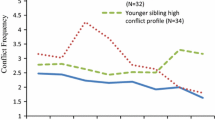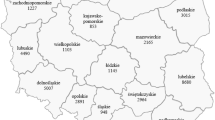Abstract
This study compared the perceived and actualdegree of family assimilation disparity among50 Hispanic refugee parent-adolescent dyads. Participants completed a behaviourquestionnaire requiring them to rate theacceptability of prototypical assimilativeadolescent behaviours from both their ownperspective and that of the other familymember. Dependent sample t-tests revealed thatthe Hispanic parents and adolescentssignificantly underestimated or overestimatedthe actual degree of intergenerational gaps.These findings attest to the existence ofhealth-promoting and health-compromisingbeliefs about assimilation disparity, asincongruence between parents' and adolescents'levels of assimilation is associated with avariety of negative individual and familyoutcomes. Implications for counselling arediscussed.
Similar content being viewed by others
References
Baptiste, D.A. (1993). Immigrant families, adolescents, and acculturation: Insights for therapists. Marriage and Family Review 19(3-4): 341-363.
Berry, J.W. (1997). Immigration, acculturation, and adaptation. Applied Psychology: An International Review 46(1): 5-16.
Coyne, J.C. & Downey, G. (1991). Social factors and psychopathology: Stress, social support, and coping processes. Annual Review of Psychology 42: 401-425.
Damji, T., Clement, R. & Noels, K.A. (1996). Acculturation mode, identity variation, and psychosocial adjustment. Journal of Social Psychology 136(4): 493-500.
Dressler, W.W. (1985). Psychosomatic symptoms, stress, and modernization: A model. Culture, Medicine & Psychiatry 9: 257-286.
Folkman, S. & Moskowitz, J.T. (2000). Positive affect and the other side of coping. American Psychologist 55: 647-654.
Folkman, S., Shaeffer, S. & Lazarus, R.S. (1979). Cognitive processes as mediators of stress and coping. In V. Hamilton & D. Warburton (eds.), Human stress and cognition (pp. 95-105). London: John Wiley.
Gil, A.G. & Vega, W.A. (1996). Two different worlds: Acculturation stress and adaptation among Cuban and Nicaraguan families. Journal of Social and Personal Relationships 13(4): 435-456.
Hiebert, B. (1983). A framework for planning stress control interventions. Canadian Counsellor 17: 51-61.
Hiebert, B. (1988). Controlling stress: A conceptual update. Canadian Journal of Counselling 22(4): 226-241.
Hovey, J.D. & King, C.A. (1996). Acculturative stress, depression, and suicidal ideation among immigrant and second-generation Latino adolescents. Journal of the American Academy of Child & Adolescent Psychiatry 35(9): 1183-1192.
Huang, L.N. (1994). An interactive approach to clinical assessment and intervention with Asian American adolescents. Journal of Clinical Child Psychology 23(1): 21-31.
Larson, M.L. (1984). Meaning-based translation: A guide to cross-language equivalence. Lanham, MD: University Press of America.
Lazarus, R.S. & Folkman, S. (1984). Stress, appraisal, and coping. New York: Springer.
Lipson, J.G. (1992). The health and adjustment of Iranian immigrants. Western Journal of Nursing Research 14(1): 10-29.
Magnusson, D. (1982). Situational determinants of stress: An interactional perspective. In L. Goldberger & S. Breznitz (eds.), Handbook of stress: Theoretical and clinical aspects (pp. 59-87). New York: The Free Press.
Merali, N. (1996). Immigrants' perceptions of the degree of acceptability of acculturated adolescent behaviours. Master's Thesis. University of Calgary, Calgary, AB.
Noels, K.A. (1999). General and acculturation-related daily hassles and psychological adjustment in first and second generation South Asian immigrants to Canada. Paper presented at the International Conference on Immigration and Integration sponsored by the Society for the Psychological Study of Social Issues, August, 1999. Toronto, ON.
Pernice, R. (1994). Methodological issues in research with refugees and immigrants. Professional Psychology, Research and Practice 25(3): 207-213.
Pruegger, V. (1995). Immigrant youth symposium '95: Building tommorow today. Calgary, AB: Youth Symposium Committee.
Radloff, L. S. (1977). The CES-D scale: A self-report depression scale for research in the general population. Applied Psychological Measurement 1: 385-401.
Rick, K. & Forward, J. (1992). Acculturation and perceived intergenerational differences among Hmong youth. Journal of Cross-Cultural Psychology 23(1): 85-94.
Rogler, L.H. (1999). Methodological sources of cultural insensitivity in mental health research. American Psychologist 54: 424-433.
Roizblatt, A. & Pilowsky, D. (1996). Forced migration and resettlement: Its impact on families and individuals. Contemporary Family Therapy 18(4): 513-521.
Segal, U.A. (1991). Cultural variables in Asian Indian families. Families in Society 72(4): 233-241.
Silverstein, M. & Chen, X. (1999). The impact of acculturation in Mexican American families on the quality of adult grandchild-grandparent relationships. Journal of Marriage and the Family 61(1): 188-198.
Taylor, S.E., Kemeny, M.E., Reed, G.M., Bower, J.E. & Gruenewald, T.L. (2000). Psychological resources, positive illusions, and health. American Psychologist 55: 99-109.
Tran, T.V. (1993). Psychological traumas and depression in a sample of Vietnamese refugees in the United States. Health and Social Work 18(3): 184-194.
Zuckerman, M. (1999). Vulnerability to psychopathology: A biosocial model. Washington, DC: American Psychological Association.
Author information
Authors and Affiliations
Rights and permissions
About this article
Cite this article
Merali, N. Perceived versus actual parent-adolescent assimilation disparity among hispanic refugee families. International Journal for the Advancement of Counselling 24, 57–68 (2002). https://doi.org/10.1023/A:1015081309426
Issue Date:
DOI: https://doi.org/10.1023/A:1015081309426




